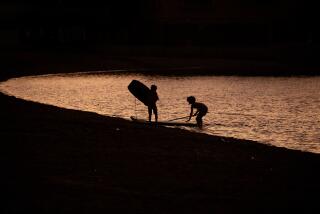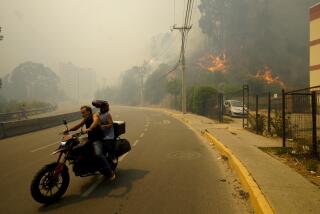Changing Climate’s Threat to Water Seen
MEXICO CITY — Droughts, floods, changing rain patterns and rising sea levels are threatening development in the world’s poorest countries, experts and aid workers said Monday at an international water forum.
Regions including Africa and South Asia -- home to most of the 1.1 billion people who live without clean water -- will be among the hardest hit by changing weather patterns, experts at the 4th World Water Forum said. They blamed the threats largely on changes in the global climate.
“Droughts will worsen. We will see deforestation, forest fires, a loss of biodiversity and degradation of the environment,” said Michel Jarraud, secretary-general of the World Meteorological Organization. “The least developed countries are the most affected. Often, developing countries don’t have the resources to mitigate the impact.”
Greenhouse gases such as carbon dioxide have been increasing in the atmosphere since the Industrial Revolution, raising fears that they are warming the planet’s climate by trapping heat from the sun.
Scientists worry that overall warming will melt glaciers and the polar ice caps, raising sea levels enough to damage many low-lying islands and cities. In addition, a warmer climate could lead to changes in weather patterns and agriculture, and even allow some diseases to expand into new areas.
Gana Unnayan Sangstha, an aid worker who helps install community water systems in Bangladesh’s poor coastal province of Satkhira, said he had seen the effects of global warming.
“Bangladesh is the lowestlying country in the world. There are salinity intrusions into larger areas due to climate change, and a rise in sea-water levels,” Unnayan Sangstha said. When salt gets into ground water -- such as in the wells used in many Bangladesh projects -- it becomes useless for drinking or irrigation.
Increasing salinity is also a problem in areas near Karachi, Pakistan, where Tanveer Arif works on a rural-aid project aimed at building ponds that collect water in an arid environment. He does not blame the increased salinity on global warming, but has noted there is less rain for his ponds to capture.
“Since about two decades ago, there is some climate change, and the rains are moving to the east,” Arif said.
The head of Mexico’s national weather service said much of his country’s Yucatan coast could eventually be flooded by rising sea levels. Jamie Pittock, executive director of the World Wildlife Fund, said major rivers could be affected by global warming.
“Rivers like the Indus and Ganges could see reduced flow,” he said. “At the moment, they have a steady base flow from melting glaciers, but when those glacier flows are reduced, the rivers will become more flashy, with greater flows in the wet season and lower flows in the dry season.”
More to Read
Sign up for Essential California
The most important California stories and recommendations in your inbox every morning.
You may occasionally receive promotional content from the Los Angeles Times.










